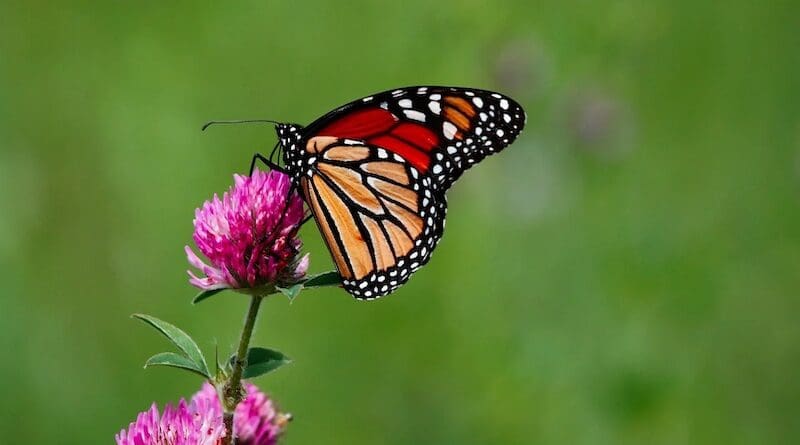What We Know About Monarch Migration: The Amazing ‘Last Mile’ – OpEd
By Stephen Day
How does the monarch butterfly (Danaus plexippus)navigate the so-called “last mile,” or final stretch, of its migration? The precision with which these little insects home in on their target destination is nothing short of astounding. The question has foxed entomologists over the years.Scientists agree that monarchs use a complex group of sensors, mainly on their antennae, to determine when and where to migrate. Many years ago, I spoke with an entomologist specializing in monarch studies. I asked him what exactly would happen to the butterflies’ migration capabilities if their antennae were removed one at a time. “Well, of course, they couldn’t migrate, feed on nectar [or] lay their eggs on milkweed plants to reproduce. It’s their antennae, stupid,” he answered brazenly.
Scientists have since peeled the proverbial onion and located light and temperature sensors in a monarch’s antenna, which recognize the time of day and the sun’s position in the sky. Another section of the brain comprising iron molecules uses this information to act as a GPS-like magnetic compass. These all are connected to the monarch’s stereoscopic antennae sensors. These functions explain how the East and West Coast monarch species know when to initiate migration, and how they can find their cardinal directions, and specific roosting sites.
Now the question becomes: How do East Coast monarchs manage to migrate several thousand miles to the same small area — a few acres of high-altitude oyamel fir trees (Abies religiosa) in Mexico — when most are making their journey for the first time? The fact that an insect brain tiny enough to be smeared on a human thumb nail can conquer this exquisite conundrum is a natural wonder.
As Alice from Lewis Carroll’s Alice in Wonderland novels might have pondered, this gets “curiouser and curiouser.”
Are the butterflies sniffing their way home?
My working hypothesis is that the monarch’s genes provide extraordinary sensors to deal with long-distance migration and the last mile. Hypothetically, the sensors would especially help with overwintering migration and the return journey to breed on alkaloid milkweed plants.
An excellent study published in February 2024 gave my hypothesis a tantalizing clue. This article from The New York Times highlighted the damaging effect pollution can have on a tobacco hawk moth’s attraction to pale evening primroses. Dr. Joel Thornton, an atmospheric chemist, led the study.
“A flower’s scent is a complex olfactory bouquet that contains many chemical compounds. To identify the ingredients in the signature primrose scent, the scientists fastened plastic bags over the blooms, capturing samples of the fragrant air. When the team analyzed these samples in the lab, it identified 22 distinct chemical components,” Thornton wrote. Naturally, his “olfactory bouquet” comment applies to a fir’s scent also.
Without getting too technical, the moths’ antennae seem specifically adapted to detect monoterpenes (C10H16), dimers of isoprene. These can be divided into acyclic, monocyclic, bicyclic and tricyclic compounds. Monoterpene derivatives that typically contain oxygen or nitrogen atoms are known as monoterpenoids. These monoterpenes give firs their distinctive aroma. According to my hypothesis, oyamel firs provide the distinctive airborne chemical signature that East Coast monarchs use to locate their overwintering destination in Mexico.
Here is a hypothesis about the last mile of the East Coast monarch’s wintering migration. It follows the Occam’s razor principle — the assumption that a simple solution is more likely to be correct than a complicated one.
The monarch’s antennae contain monoterpenoid receptors. Evolution has fine-tuned these receptors to detect specific complex chemicals at the molecular level. In this case, they detect chemicals from oyamel firs for East Coast monarch butterflies to allow them to overwinter in a sufficiently favorable climate.
As East coast monarchs approach the North Mexico border area in a southwesterly direction, they use their hypersensitive antennae to detect airborne chemical monoterpenes at a few parts per billion. This is analogous to the read-only memory (ROM) once used in our computing technology. As the concentration of airborne monoterpenes specific to oyamel firs increases, the chemical “ROM” on the antennae guides the monarch to its specific wintering habitat. Hundreds of thousands of monarchs gather here, all guided by the same function.
Concluding thoughts on other monarchs
Monarch butterflies have other overwintering migration routes, including the West Coast of North America, continental Europe, Asia and Africa. I observed the latter during my youth, in fact. As a young butterfly collector, I spent summer months witnessing monarchs at Zamalek Park in Cairo, Egypt. The African monarch (Danaus chrysippus) is widespread in Africa and Asia.
The US Forest Service explains the migration habitation of American West Coast monarchs: “Monarchs living west of the Rocky Mountain range in North America overwinter in California along the Pacific coast near Santa Cruz and San Diego. Here microclimatic conditions are very similar to that in central Mexico. Monarchs roost in eucalyptus, Monterey pines, and Monterey cypresses in California.”
Perhaps not just D. plexippus but all geographic groups of monarchs use adapted monoterpenes for last mile navigation and migration when climatic factors require overwintering at a specific low temperature range.
Like Thornton’s tobacco hawk moth study, my hypothesis requires confirmation.
The views expressed in this article are the author’s own and do not necessarily reflect Fair Observer’s editorial policy.
- About the author: Stephen Day has more than 40 years of rich business experience in American, European and Japanese markets. From 1991 to 2005, he was CEO and founder of International Ventures Associates, a private consulting and investment company providing strategic advice and investment support for telecoms, information technology and software industries. Prior to his entrepreneurial career, Day spent nine years at COMSAT in a variety of senior management positions, including VP Ventures where he directed the commercialization of COMSAT’s satellite technology. He has been a member of two external advisory boards for NASA. Day is also a painter and a writer.
- Source: This article was published at Fair Observer

